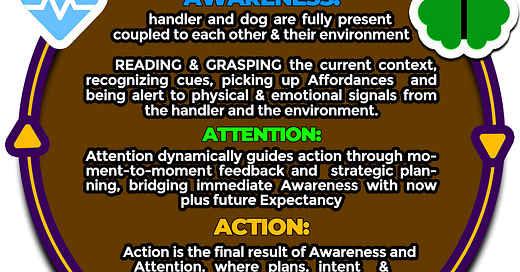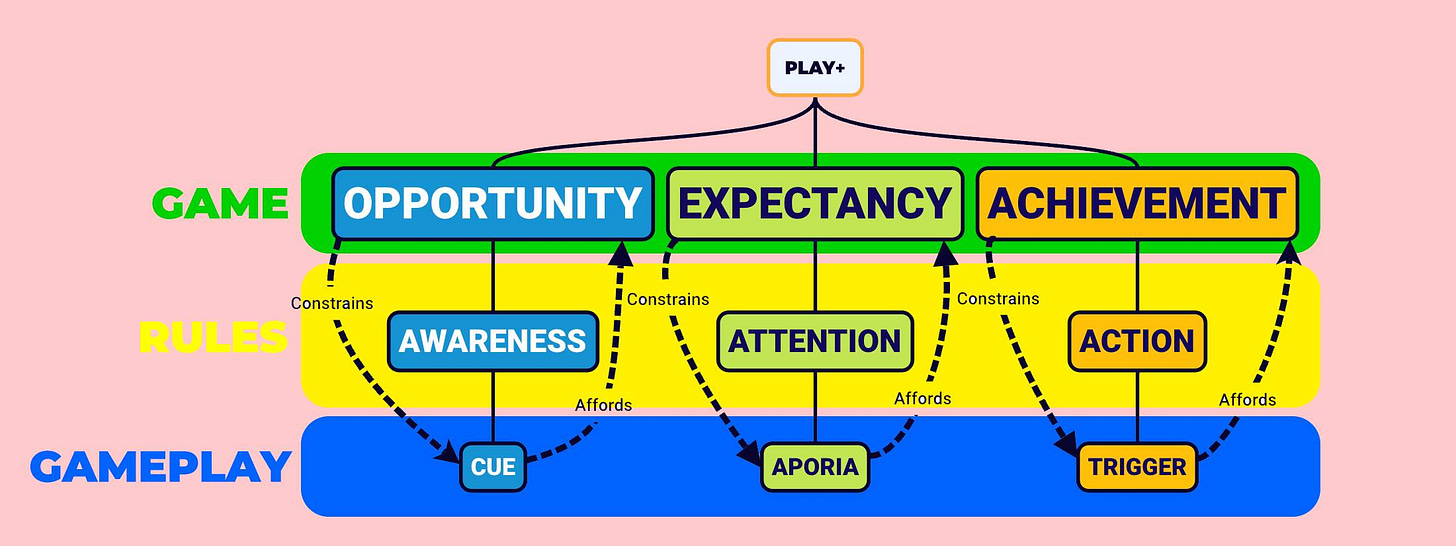On RULES: Orchestrating Intelligent Play
Marrying Mind to World Through Awareness, Attention, and Action
The RULES layer is the process layer of play—the realm of methods and mechanics, intent and interpretation, focus and feedback. While all of our thoughtful information runs through this space, not all of it proves relevant. This is where optical and relational flow is managed, information is filtered, and possibility is made playable.
I swing back and forth between calling this the process layer and the correspondence layer, and both are accurate—it just depends on how you’re looking at it. The RULES layer corresponds reality with expectations and intent, and it also processes intent and massages expectations to fit that which the situation affords. In PLAY+ this layer is highly functional, rooted in and corresponded to a directly perceived, one world, objective reality. That means it marries your mind to the actual world.
Knowledge of process affords understanding of other players intent, action, and capabilities. It also enhances gaze control and Awareness. Knowledge of process is an action capacity that enables reliable disclosure of affordances of action and teamwork.
The GAME layer offers intentional possibility (e.g., the freedom to strategize in chess). The GAMEPLAY layer provides situational feedback (e.g., reacting to an opponent’s move). The RULES layer sits between the two, bridging action and meaning while orchestrating the structure and flow of relevant information.
This is where play becomes intelligent—not in the mind, but in the fit between readiness and the real.
🎯 Core Functional Tools
Awareness | Attention | Action are coupling points. Each are where the ideal couples with with the actual. This is where the Ideal and the Actual Worlds meet.
At root:
Awareness – Scans the field of affordances; discloses what could matter.
Attention – Selects from awareness; narrows perception to relevant affordances.
Action – Moves toward coupling; not raw behavior, but action-in-readiness.
But you are in the field of affordances. Your dog is in the field of affordances. Your dog’s abilities are in in there as well. What is relevant? What should I be ready for?
Awareness | Attention | Action is what we got. There are too many variables in your training environment, and any one of them can hit the radar of your intention at any time. Information is selected, and found relevant based upon the structure of the RULES of the GAME.
In addition to intentional stuff, we’ve got to devote Attention | Awareness | Action to the process of picking up information. For example:
Does this Jump Afford an Over? Yes.
Where is the dog in relation to the jump?
Ok, so we keep our gaze anchored on the collection point, watch the dog with peripheral vision, read the timing via optic flow, and deliver a timely cue. Can’t be doing all that if we’re looking in the back of our heads for answers.
Awareness and Attention are hot commodities and they are in demand and in short supply when doing highly skilled work. They need to be attuned to the task at hand and fit to the environment.
Sense of Process is Common Sense
In any game, process = common sense: when players understand the flow, they naturally spot relevant cues, couple cleanly, and make sound decisions. In PLAY+, that process is anchored to what actually happens in the world.
When the RULES correspond to ideas instead of reality, things get weird.
Take a popularity contest: someone “wins,” but why? Tomorrow’s votes could flip the result because the metric is feelings, not objective performance.
Dog training is no different. If the process is hidden—or tied to theory instead of direct perception and interaction—you may get results, but you won’t understand what’s driving them, how they’re shaped, or when they’ll fall apart.
PLAY+ plus Common-Sense Realism marries mind to world. Peg your framework to reality and the process is clear, teachable, and repeatable. Peg it to abstractions and it turns to guesswork—magic when it works, mystery when it doesn’t.
Marrying the GAME to GAMEPLAY
Common Sense marries mind to the world. The world comes in, we perceive it, and then our mind has to deal with reality with the tools at hand– our experience and our senses.
"Married" is a key term. Most learning theories don’t marry—they synthesize.
Synthesis creates something new. It’s neither what happened in the environment nor the rules of the mind—it’s an abstraction made concrete.
But Common Sense marries what happened out there with what we know in here, without fusing them.
They remain two things: separable, movable, and interpretable. That separation is functional. It's what lets us work with reality, not just react to it.
This is a defining trait of the RULES layer in PLAY+ that holds for both dog and handler. Both are made aware of reality on the ground—and that reality is married to the mind of both critters. That’s how we find our fit, together.
🔧 Play+ Specific Tools Active in the RULES Layer
Below is a list of the key philosophical constructs of PLAY+. These tools are known by both dog and handler through embodied experience. These tools orient both dog and handler and afford shared coupling of perceptive inputs and a shared understanding.
We’ll cover these in detail in the future:
Enriched Marking – Couples information with significance; links awareness to attention.
Inceptive Marking – Marks the exact moment of coupling; signals commitment to act.
Expectant Marking – Creates temporal and attentional tension; pre-loads the horizon.
Cue–Aporia–Trigger Process – The rhythm mechanism for timing and skill deployment.
Wait (as a Skill) – The learned discipline of poised stillness in expectancy.
Flow Ratios (3:1 / 1:3) – Shift tone toward physical drive or mental engagement.
Rhythm Contours – Adjust temporal texture and arousal; structure emotional tempo.
Initiative Transfers – Declare leadership shifts; manage who owns “Now.”
Slack Focus – Maintains broad perceptual openness; prevents fixation.
Action Capacity Tuning – Adjust which affordances are perceived as available.
Ideal Skill Availability – Access to known, ready-to-hand skills from the Ideal Horizon.
Affordance Landscape Shaping – Real-time filtering of what shows up as usable.
Ideal Horizon – The mental field of all possible, relevant, skill-ready affordances.
Modulating Tone & Aim – Tunes emotional resonance (tone) and directional intent (aim) in real-time interaction.





